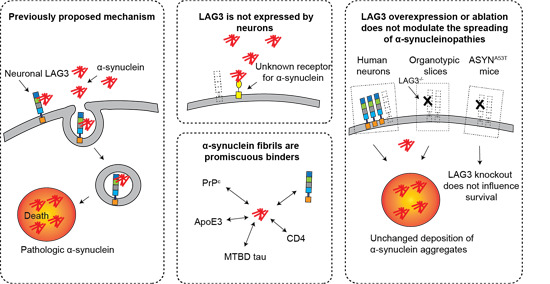The Polymenidou group and collaborators show that LAG3 does not modulate α-synucleinopathies
LAG3 is not expressed in human and murine neurons and does not modulate α-synucleinopathies
Recently, it was proposed that neuronal lymphocyte-activation gene 3 (LAG3) may function in the central nervous system as a receptor of pathogenic α-synuclein assemblies, which are causally involved in Parkinson’s disease. This study investigated this putative role of the LAG3 immune checkpoint molecule in the spread of α-synucleinopathies by analysing the expression pattern of LAG3 in human and mouse brains. Despite using various methods and model systems, no evidence was found for LAG3 expression in neurons. While the interaction of LAG3 with α-synuclein fibrils was confirmed, the specificity of this interaction appeared limited. Moreover, overexpression of LAG3 in cultured human neural cells did not cause increased deposition of α-synuclein aggregates ex vivo and overall survival of human A53T α-synuclein transgenic mice was unaffected by LAG3 depletion. Finally, the seeded induction of α-synuclein lesions in hippocampal slice cultures was unaffected by LAG3 knockout. Overall, this study indicates that the proposed role of LAG3 in the propagation of α-synucleinopathies is not universally valid and that the search for relevant targets to slow or completely abolish the pathogenesis of neurodegenerative diseases must continue.
See Emmenegger et al,. EMBO Mol Med.
